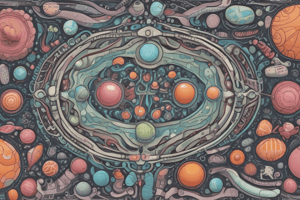Podcast
Questions and Answers
What is a common characteristic of lipids?
What is a common characteristic of lipids?
- Generally soluble in organic solvents but only sparingly soluble in water (correct)
- Generally soluble in water
- Generally soluble in both water and organic solvents
- Generally insoluble in organic solvents
What is the primary function of lipids in food?
What is the primary function of lipids in food?
- To add texture and taste to food
- To cushion vital organs and transport fat-soluble nutrients
- To regulate hormones and transmit nerve impulses
- To provide high caloric density and contribute to satiety (correct)
What is the function of cholesterol in animal biochemical processes?
What is the function of cholesterol in animal biochemical processes?
- Maintenance of blood lipid composition
- Regulation of blood pressure
- Transportation of vitamins through the blood
- Regulation of membrane fluidity and precursor for all steroid hormones (correct)
What is the product of hydrolysis of glycerides?
What is the product of hydrolysis of glycerides?
What is the characteristic of complex/compound lipids?
What is the characteristic of complex/compound lipids?
What is the basic building block of terpenoids?
What is the basic building block of terpenoids?
What is an example of a derived lipid?
What is an example of a derived lipid?
What is the main component of oils and fats?
What is the main component of oils and fats?
How many isoprene units are present in sesquiterpenes?
How many isoprene units are present in sesquiterpenes?
What is the name given to terpenes with more than 100 isoprene units?
What is the name given to terpenes with more than 100 isoprene units?
Flashcards are hidden until you start studying
Study Notes
Definition and Functions of Lipids
Lipids are a broad group of compounds that are generally soluble in organic solvents but only sparingly soluble in water.
- Lipids perform various functions both within the body and in food, including serving as an energy reserve, regulating hormones, transmitting nerve impulses, cushioning vital organs, and transporting fat-soluble nutrients.
- In food, lipids serve as an energy source with high caloric density, add texture and taste, and contribute to satiety.
Classes of Lipids
- Lipids can be broadly classified into three main groups: simple lipids, complex (or compound) lipids, and derived lipids.
Simple Lipids
- Yield two classes of products when hydrolyzed.
- Examples: glycerides (acylglycerols) and waxes.
- Glycerides yield glycerol and fatty acid (FA) when hydrolyzed.
- Waxes yield long-chain alcohol and long-chain fatty acid when hydrolyzed.
Complex (or Compound) Lipids
- Yield three or more classes of products when hydrolyzed.
- Examples: phospholipids, sphingomyelins, cerebrosides, and gangliosides.
- Phospholipids yield alcohols, fatty acids (FAs), and phosphoric acid when hydrolyzed.
- Sphingomyelins yield sphingosine, FA, phosphate, and choline when hydrolyzed.
- Cerebrosides yield sphingosine, FA, and simple sugar when hydrolyzed.
- Gangliosides yield sphingosine, FA, and complex carbohydrate moiety that includes sialic acid when hydrolyzed.
Derived Lipids
- Meet the definition of a lipid but do not fit into either simple or compound lipids.
- Are non-hydrolyzable.
- Examples: carotenoids, sterols (e.g., cholesterol), and fat-soluble vitamins (e.g., tocopherol and vitamin A).
Derived Lipid Examples
Cholesterol
- An important lipid in animal biochemical processes that controls the fluidity of membranes.
- The precursor for all steroid hormones.
- Has a hydrophobic structure made up of adjacent carbon rings.
Terpenoids
- A diverse, complex chemical group of lipid-type molecules.
- Most are multi-cyclic compounds made via successive polymerization and cyclization reactions derived from the 5-C building block isoprene.
- Important to flavor and aroma profiles of seasonings, herbs, and fruits.
- Classified based on the number of isoprene units incorporated in the basic molecular skeleton.
Composition of Edible Lipids
- Dietary or edible lipids are commonly referred to as oils (liquid at room temperature) and fats (solid or semisolid at room temperature).
- Oils and fats are largely composed of mixtures of triglycerides.
- Triglycerides, also known as triacylglycerols (TAGs), are derivatives of fatty acids (FAs) or esters of three FAs with glycerol.
- TAGs make up about 99% of the lipids of plant and animal origin.
- Other components of oils and fats may include free fatty acids (FFAs), monoacylglycerols (MAGs), diacylglycerols (DAGs), phospholipids, carotenoids, sterols, and vitamins (A, D, E, K, etc.).
Studying That Suits You
Use AI to generate personalized quizzes and flashcards to suit your learning preferences.




